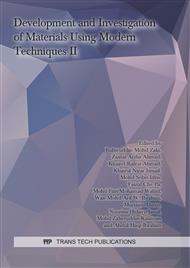[1]
Sabbas, Thomas, Alessandra Polettini, Raffaella Pomi, Thomas Astrup, Ole Hjelmar, Peter Mostbauer, Giovanna Cappai, Gabi Magel, Stefan Salhofer, Claudia Speiser, Soraya Heuss-Assbichler, R. Klein, and Peter Lechner, Management of municipal solid waste incineration residues, Waste Management 23 (2003) 61-88.
DOI: 10.1016/s0956-053x(02)00161-7
Google Scholar
[2]
Maria, I., Xavier, Q., Alejandro, J., Enric, V., Angel, L.S, Comparison between laboratory and field leachability of MSWI bottom ash as a road material, Sci. Total Environ. 389 (2008) 10-19.
DOI: 10.1016/j.scitotenv.2007.08.020
Google Scholar
[3]
Lin, Y.C., Panchangam, S.C., Wu, C.H., Hong, P.K.A., Lin, C.F., Effects of water washing on removing organic residues in bottom ashes of municipal solid waste incinerators, Chemosphere 82 (2011) 502-506.
DOI: 10.1016/j.chemosphere.2010.11.010
Google Scholar
[4]
Colangelo, F., Cioffi, R., Montagnaro, F., Santoro, L., Soluble salt removal from MSWI fly ash and its stabilization for safer disposal and recovery as road basement material, Waste Management 32 (2012) 1179-1185.
DOI: 10.1016/j.wasman.2011.12.013
Google Scholar
[5]
Cornelis, G., Gerven, T.V., Vandecasteele, C., Antimony leaching from MSWI bottom ash: modelling of the effect of pH and carbonation, Waste Management 32 (2012) 278-286.
DOI: 10.1016/j.wasman.2011.09.018
Google Scholar
[6]
Li, X. G., Lang, L., Ma, B. G., Chen, Q. B., Yin, X. B. & Jian, S. W., Utilization of municipal solid waste incineration bottom ash in blended cement, Journal of Cleaner Production 32 (2012) 96-100.
DOI: 10.1016/j.jclepro.2012.03.038
Google Scholar
[7]
Powers, T.C. The Properties of Fresh Concrete, J. Wiley & Sons, New York, 1968, pp.533-652.
Google Scholar
[8]
Frias, M., Sanchez de Rojas, M.I., Cabrera, J., The effect that the pozzolanic reaction of metakaolin has on the heat evolution in metakaolin-cement mortars, Cement and Concrete Research 30 (2000) 209–216.
DOI: 10.1016/s0008-8846(99)00231-8
Google Scholar
[9]
Sarmiento, L. M., Clavier, K. A., Paris, J. M., Ferraro, C. C., and Townsend, T. G., Critical examination of recycled municipal solid waste incineration ash as a mineral source for portland cement manufacture – A case study, Resources, Conservation and Recycling 148 (2019) 1–10.
DOI: 10.1016/j.resconrec.2019.05.002
Google Scholar
[10]
Neville, A. M., & Brooks, J. J., Concrete Technology second ed., Harlow, Pearson Education Limited, (2010).
Google Scholar
[11]
Cheng, An., Effect of Incinerator Bottom Ash Properties on Mechanical and Pore Size of Blended Cement Mortars, Materials and Design. 36 (2012) 859.
DOI: 10.1016/j.matdes.2011.05.003
Google Scholar
[12]
Abeykoon, A.J. Anthony, C.S. Subashi De Silva, G.H., Bottom Ash as a Replacement of Sand for Manufacturing Masonry Blocks, Concrete Research Letters 1 (2012).
Google Scholar
[13]
Mehta, P.K. Aitcin, P.C., Principles underlying production of high performance concrete, Cem. Concr. Aggr., 12 (1990) 70-78.
Google Scholar
[14]
Hewlett Leas, P.C., Chemistry of cement and concrete Elsevier forth Ed., Butterworth- Heinmann (2004).
Google Scholar
[15]
Didamony, H. EL. Enein, S. EL. Ali, A.H. Sokkary, T.M. EL., Effect of silica fume on the slag cement containing wet cement dust ind. J Eng. Mater., 6 (1999) 274-278.
Google Scholar


